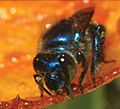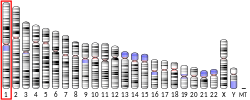Eufriesea is a genus of euglossine bees. Like all orchid bees, they are restricted to the Neotropics. All species range from entirely to at least partially...
10 KB (739 words) - 02:06, 4 February 2024
Eufriesea purpurata is a species of eusocial orchid bee common in northeastern South America, particularly in the Amazon basin. It is an important pollinator...
11 KB (1,106 words) - 06:03, 5 July 2024
Eufriesea flaviventris is a species of bee in the family Apidae, tribe Euglossini (orchid bees). "Species details : Eufriesea flaviventris (Friese, 1899)"...
889 bytes (29 words) - 08:43, 9 February 2021
200 described species, distributed in five genera: Euglossa, Eulaema, Eufriesea, Exaerete and the monotypic Aglae. All species occur in South or Central...
11 KB (1,320 words) - 15:34, 27 June 2024
Eufriesea surinamensis belongs to the tribe of euglossine bees and as such is a species of orchid bee. This should not be mistaken with the species group...
21 KB (2,520 words) - 02:37, 27 November 2022
they are cleptoparasites in the nests of other euglossines in the genera Eufriesea and Eulaema. It contains the following species: Exaerete azteca Moure...
3 KB (240 words) - 17:20, 28 April 2023
of other large euglossine bees, especially in the genera Eulaema and Eufriesea. Exaerete frontalis is found from Central America to central South America...
2 KB (128 words) - 23:48, 13 July 2023
morphologically and chromatically atypical for the genus, and resembles the related Eufriesea in a number of characters including coloration. Euglossa occurs naturally...
14 KB (362 words) - 07:48, 8 December 2023
bumblebees. They lack metallic coloration as occurs in the related genus Eufriesea. Eulaema is found from Rio Grande do Sul (Brazil), Misiones (Argentina)...
10 KB (954 words) - 19:34, 1 February 2024
Brazil. It is the type species of the genus Stanhopea. The orchid bee Eufriesea purpurata is the sole pollinator of Stanhopea insignis, which attracts...
2 KB (101 words) - 01:59, 3 March 2024
kleptoparasite of three orchid bee genera: Eufriesea, Eulaema, and Exaerete Known host species: Eufriesea dentilabris Eufriesea violacea Eulaema cingulata Eulaema...
8 KB (724 words) - 22:41, 27 February 2024
"Revisiting the organohalogens associated with 1979-samples of Brazilian bees (Eufriesea purpurata)". Science of the Total Environment. 377 (2–3). Elsevier BV:...
7 KB (544 words) - 04:13, 15 November 2023
do not build nests, as they are kleptoparasites of Eulaema nigrita and Eufriesea surinamensis. Usually they wait for the host bees to leave the nest, then...
3 KB (207 words) - 23:51, 13 July 2023
a moth endemic to Hawaii Eudromia formosa, a South American tinamou Eufriesea formosa, a euglossine bee Eulepidotis formosa, a neotropical moth Eupithecia...
575 bytes (92 words) - 18:18, 4 April 2014
2012 (a genus of damselfly-like odonates from the Permian of Russia) Eufriesea engeli Gonzalez & Griswold, 2017 (an orchid bee from Mexico) † Kronocharon...
26 KB (2,234 words) - 09:10, 25 April 2024
found in other locations, where the populations are considered sporadic. Eufriesea purpurata, a bee that collects DDT Wikimedia Commons has media related...
6 KB (664 words) - 19:24, 3 March 2024
formulated on the relationships of these genera (Aglae, Exaerete, Euglossa, Eufriesea, and Eulaema). No definite conclusion has been reached because of the...
23 KB (2,798 words) - 17:26, 5 July 2021
- NCBI". www.ncbi.nlm.nih.gov. Retrieved 2020-05-03. "Protein FAM89A [Eufriesea mexicana] - Protein - NCBI". www.ncbi.nlm.nih.gov. Retrieved 2020-05-03...
25 KB (2,102 words) - 11:04, 31 March 2024
presence of some large species' pollinia observed on the back of male Eufriesea violacea bees (Euglossinae), and of Bombus brasiliensis (Bombini). Although...
34 KB (3,498 words) - 21:08, 15 March 2024
Vereinigung Wissenschaftlicher Verleger, Berlin, Leipzig 1922 The bee genus Eufriesea is named after him, along with stingless bee (Meliponini) genus Frieseomelitta...
3 KB (270 words) - 19:48, 26 December 2023
Apis clavicornis Apis centuncularis Apis cineraria Apis surinamensis – Eufriesea surinamensis Apis retusa Apis rufa Apis bicornis Apis truncorum Apis dentata...
17 KB (1,142 words) - 07:57, 10 July 2023
234 37.3 Drosophila mojavensis (Fruit fly) XP_002009472.2 736 239 36.3 Eufriesea mexicana (Orchid bee) XP_017762298.1 736 227 26.8 Trichoplax adhaerens...
22 KB (1,931 words) - 11:25, 11 February 2024
being genetically distinct from the lineage of the other four genera Eufriesea, Eulaema, Aglae, Exaerete. The genus Euglossa (Latreille, 1802) is made...
7 KB (781 words) - 09:54, 27 September 2023
consists of approximately 240 species grouped into five genera—Euglossa, Eufriesea, Eulaema, Exaerete, and Aglae— all of which are spread from northern Mexico...
26 KB (3,651 words) - 18:47, 7 May 2021
mimicry in the Amazon basin and Guiana highlands are the Eufriesea ornate and the Eufriesea limbata who have similar tergum patterns and colors to the...
43 KB (5,687 words) - 18:42, 27 June 2024



















